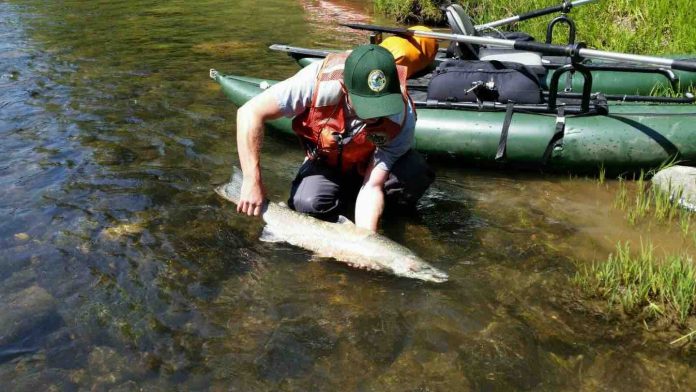Steelhead trout (Oncorhynchus mykiss) stir up the sediment of the river bed when building their spawning pits, thus influencing the composition of the river bed and the transport of sediment. Until now, this process could only be studied visually, irregularly and with great effort in the natural environment of the fish. Now, researchers led by Michael Dietze of the GFZ German Research Centre for Geosciences in Potsdam have used seismic sensors (geophones) to analyze the trout’s nest-building process in detail. The study was published in the journal Earth Surface Processes and Landforms.
To lay their eggs, trout use their caudal fins to dig pits up to three metres long on each side and ten centimetres deep into the river bed. The aim of the researchers was to locate these spawning pits and to analyze the chronological sequence of the construction process. To this end, the researchers set up a network of seismic stations on a 150-meter section of the Mashel River in the US state of Washington. The geophones embedded in the earth are highly sensitive and detect the slightest vibrations in the ground. Small stones moved by the fish caused short frequency pulses in the range of 20 to 100 hertz and could be distinguished from background frequencies of flowing water, raindrops and even the pulses of passing airplanes. “The same signal arrives at each of the stations slightly delayed. This enabled us to determine where the seismic wave was generated,” says Dietze, first author of the study.
The researchers listened to the construction of four spawning pits for almost four weeks from the end of April to the end of May. The geophones revealed that the trout were mostly busy building their nests within eleven days of the measurement period. The fish preferably started at sunrise and were active until early noon, followed by another period in the early evening. The trout dug in the sediment for between one and twenty minutes, typically at two- to three-minute intervals with 50 to 100 tail strokes. This was followed by a break of about the same length.
“Normally, the nest-building behaviour of the trout was recorded only very irregularly, at most weekly. We can now resolve this to the millisecond. In the future, we want to extend the method to the behaviour of other species, for example animals that dig along the banks and destabilize them,” explains Dietze. The new measurement method might support fish and behavioural biology and provide a more accurate picture of the biotic and abiotic contribution of sediment transport in rivers. “Fish can move as much sediment as a normal spring flood. The biological component can therefore play a very important role,” said Dietze.




